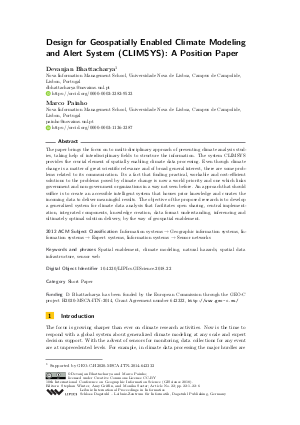Design for Geospatially Enabled Climate Modeling and Alert System (CLIMSYS): A Position Paper (Short Paper)
Authors
Devanjan Bhattacharya  ,
Marco Painho
,
Marco Painho 
-
Part of:
Volume:
10th International Conference on Geographic Information Science (GIScience 2018)
Part of: Series: Leibniz International Proceedings in Informatics (LIPIcs)
Part of: Conference: International Conference on Geographic Information Science (GIScience) - License:
 Creative Commons Attribution 3.0 Unported license
Creative Commons Attribution 3.0 Unported license
- Publication Date: 2018-08-02
File

PDF
LIPIcs.GISCIENCE.2018.22.pdf
- Filesize: 435 kB
- 6 pages
Document Identifiers
Subject Classification
ACM Subject Classification
- Information systems → Geographic information systems
- Information systems → Expert systems
- Information systems → Sensor networks
Keywords
- Spatial enablement
- climate modeling
- natural hazards
- spatial data infrastructure
- sensor web
Metrics
- Access Statistics
-
Total Accesses (updated on a weekly basis)
0PDF Downloads0Metadata Views
Abstract
The paper brings the focus on to multi-disciplinary approach of presenting climate analysis studies, taking help of interdisciplinary fields to structure the information. The system CLIMSYS provides the crucial element of spatially enabling climate data processing. Even though climate change is a matter of great scientific relevance and of broad general interest, there are some problems related to its communication. Its a fact that finding practical, workable and cost-efficient solutions to the problems posed by climate change is now a world priority and one which links government and non-government organizations in a way not seen before. An approach that should suffice is to create an accessible intelligent system that houses prior knowledge and curates the incoming data to deliver meaningful results. The objective of the proposed research is to develop a generalized system for climate data analysis that facilitates open sharing, central implementation, integrated components, knowledge creation, data format understanding, inferencing and ultimately optimal solution delivery, by the way of geospatial enablement.
Cite As Get BibTex
Devanjan Bhattacharya and Marco Painho. Design for Geospatially Enabled Climate Modeling and Alert System (CLIMSYS): A Position Paper (Short Paper). In 10th International Conference on Geographic Information Science (GIScience 2018). Leibniz International Proceedings in Informatics (LIPIcs), Volume 114, pp. 22:1-22:6, Schloss Dagstuhl – Leibniz-Zentrum für Informatik (2018)
https://doi.org/10.4230/LIPIcs.GISCIENCE.2018.22
BibTex
@InProceedings{bhattacharya_et_al:LIPIcs.GISCIENCE.2018.22,
author = {Bhattacharya, Devanjan and Painho, Marco},
title = {{Design for Geospatially Enabled Climate Modeling and Alert System (CLIMSYS): A Position Paper}},
booktitle = {10th International Conference on Geographic Information Science (GIScience 2018)},
pages = {22:1--22:6},
series = {Leibniz International Proceedings in Informatics (LIPIcs)},
ISBN = {978-3-95977-083-5},
ISSN = {1868-8969},
year = {2018},
volume = {114},
editor = {Winter, Stephan and Griffin, Amy and Sester, Monika},
publisher = {Schloss Dagstuhl -- Leibniz-Zentrum f{\"u}r Informatik},
address = {Dagstuhl, Germany},
URL = {https://drops.dagstuhl.de/entities/document/10.4230/LIPIcs.GISCIENCE.2018.22},
URN = {urn:nbn:de:0030-drops-93504},
doi = {10.4230/LIPIcs.GISCIENCE.2018.22},
annote = {Keywords: Spatial enablement, climate modeling, natural hazards, spatial data infrastructure, sensor web}
}
Author Details
- Nova Information Management School, Universidade Nova de Lisboa, Campus de Campolide, Lisbon, Portugal
Funding
D. Bhattacharya has been funded by the European Commission through the GEO-C project H2020-MSCA-ITN-2014, Grant Agreement number 642332, http://www.geo-c.eu/.
- Bhattacharya, Devanjan: Supported by GEO-C-H2020-MSCA-ITN-2014-642332
References
- Gregory Giuliani, Stefano Nativi, Andre Obregon, Martin Beniston, and Anthony Lehmann. Spatially enabling the global framework for climate services: Reviewing geospatial solutions to efficiently share and integrate climate data and information. Climate Services, 8:44-58, 2017. URL: http://dx.doi.org/10.1016/j.cliser.2017.08.003.
- C.S.B. Grimmond, M. Roth, T.R. Oke, Y.C. Au, M. Best, R. Betts, G. Carmichael, H. Cleugh, W. Dabberdt, R. Emmanuel, E. Freitas, K. Fortuniak, S. Hanna, P. Klein, L.S. Kalkstein, C.H. Liu, A. Nickson, D. Pearlmutter, D. Sailor, and J. Voogt. Climate and more sustainable cities: Climate information for improved planning and management of cities (producers/capabilities perspective). Procedia Environmental Sciences, 1:247-274, 2010. URL: http://dx.doi.org/10.1016/j.proenv.2010.09.016.
-
J.N. Lavis, J. Lomas, M. Hamid, and N.K. Sewankambo. Assessing country-level efforts to link research to action. Bulletin of the World Health Organization, 84(8):620-626, 2006.

- Steve H.L. Liang and Chih-Yuan Huang. Geocens: A geospatial cyberinfrastructure for the world-wide sensor web. Sensors, 13(10):13402-13424, 2013. URL: http://dx.doi.org/10.3390/s131013402.
- S. Nativi, M. Craglia, and J. Pearlman. Earth science infrastructures interoperability: The brokering approach. IEEE Journal of Selected Topics in Applied Earth Observations and Remote Sensing, 6(3):1118-1129, June 2013. URL: http://dx.doi.org/10.1109/JSTARS.2013.2243113.
- NOAA. NOAA national centers for environmental information. https://www.ncdc.noaa.gov/data-access/quick-links#dsi-3505 (accessed on 20 Apr 2018).
- NOAA. NOAA national ice center. http://www.natice.noaa.gov/Main_Products.htm (accessed on 20 Apr 2018).
- Jonathan T. Overpeck, Gerald A. Meehl, Sandrine Bony, and David R. Easterling. Climate data challenges in the 21st century. Science, 331(6018):700-702, 2011. URL: http://dx.doi.org/10.1126/science.1197869.
- O. Rössler, A. M. Fischer, H. Huebener, D. Maraun, R. E. Benestad, P Christodoulides, P. M. M. Soares, R. M. Cardoso, C. Pagé, H. Kanamaru, F. Kreienkamp, and D. Vlachogiannis. Challenges to link climate change data provision and user needs–perspective from the cost‐action value. International Journal of Climatology, 0(0), 2017. URL: http://dx.doi.org/10.1002/joc.5060.
